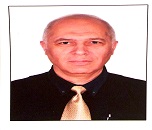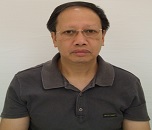Day 1 :
Keynote Forum
Juan Manuel Navarrete
Professor
Keynote: 40K radioactive detection for K quantitative analysis in foodstuff
Time : 09:30-10:10

Biography:
Juan Manuel Navarrete is a Researcher Professor in the Faculty of Chemistry, Inorganic and Nuclear Chemistry Department, from the National University of Mexico. He obtained the PhD degree from Paris VI University, Pierre et Marie Curie, in 1992.He has published about 120 papers and served as arbitrate-in-reputed-scientific-journals.
Abstract:
40K radioactive detection in foodstuff is easily performed by filling Marinelli containers with any food sample in order to detect the γ rays emitted (energy 1461 KeV, 11% decaying nucleus to 40Ar by electron capture, EC), and detectd either by one NaI(Tl) scintillation or HPGe semiconductor detector. So, if each one is used during a suitable detection time, for example 12 hours overnigth, counts number with reasonable standard deviation are accumulated, and it is possible to compare and obtain better results, when Bq per gram of sample (Bq/gs) is divided by specific activity of elementary K (31.19 Bq/gK) and multiplied by 100, to get the K concentration in the sample as percentage. In this way, to obtain Bq/gs next equation is used:
Bq/gs = Cs – Cb/Ws.xDet. Eff.x0.11 (where: Cs=counts per second obtained from sample;Cb=counts per second obtained from background; Ws=foodstuff sample weigth in grams;Det. Eff.=Detection Efficiency of each detector for 1461 KeV γ rays/100; 0.11=40K branching ratio decaying to 40Ar by EC). Elementary K specific activity is a constant obtained from next equation:
Bq/gK = λN = 0.693x6.02x1023x0.0118/1.28x109x365x24x3600x39.1x100=31.19 Bq/gK
(where: λ=40K decay constant; N=40K atoms number per K gram; 0.693=ln 2; 6.02x1023= Avogadro’s number; 0.0118/100=40K isotopic abundance;1.28x109x365x24x3600=40K half life in seconds; 39.1=Elementary K atomic weigth).
And finally:
K(o/o)=Bqx100/gs / Bq/gK = gKx100/gs
So, severalvegetables, seeds and grains have been analysed for K concentration, and this paper presents the higher K concentration in peels, related to grains of cacao and coffee, obtained by this non destructive, easy and precise enough procedure.
Keynote Forum
Diane Lebeau
Research Engineer
Keynote: Direct mass spectrometry analysis for the understanding of polymers degradation mechanisms
Time : 10:10- 10:50

Biography:
Diane LEBEAU has completed her PhD from UPMC University (Paris, France) and postdoctoral studies from Roche Diagnostics laboratories in Germany. She is research engineer in the Laboratory of Radiolysis and Organic Matter (LRMO) at the French Alternative Energies and Atomic Energy Commission (CEA, France) since 2009. As a specialist in analytical chemistry, she contributes to the research program conducted by the CEA and devoted to small organic molecules and polymer degradation in the nuclear context. She has published 10 papers.
Abstract:
Because of the wide range of formulations, one class of polymer can have different composition (nature of the monomer, quantity and concentration of monomers for copolymers, average molar mass and so on). Their additives can also be adjusted. In the area of polymers analysis, one of the most important interest is to develop analytical methods allowing a fast and complete characterization of its chemical structure. In the very special context of the nuclear industry, and more specially in the nuclear waste safety domain, degradation mechanisms of polymers have to be understood up to doses as high as dozen of MGy. At theses doses, materials are highly modified, depending on the polymer kind and on the additives. The first in the understanding of the mechanisms is to characterize materials at different doses.
Mass spectrometry allows today to analyze molecules directly from sample for rapid analysis, without any sample preparation. In this study, two ionization sources have been used, Atmospheric Solid Probe Analysis (ASAP) and Direct Analysis in Real Time (DART), for characterization of two industrial polymers, polyurethanes and polyethylene.
DART technique allows detection of additives with good intensity, whereas ASAP technique allows a better desorption of high molar mass polymers in function of their volatilization and/or degradation temperature. Thus, these results compare and contrast these two complementary thermal-based ionization techniques for the direct study of crude polymer. In the nuclear context, these two sources allow to help to follow and understand chemical modification of the polymer with dose.
- Nuclear Chemistry
Session Introduction
Juan Manuel Navarrete
Researcher Professor in Nuclear Chemistry
Title: 40K radioactive detection for K quantitative analysis in foodstuff

Biography:
Juan Manuel Navarrete is a Researcher Professor in the Faculty of Chemistry, Inorganic and Nuclear Chemistry Department, from the National University of Mexico. He obtained the PhD degree from Paris VI University, Pierre et Marie Curie, in 1992.He has published about 120 papers and served as arbitrate-in-reputed-scientific-journals.
Abstract:
40K radioactive detection in foodstuff is easily performed by filling Marinelli containers with any food sample in order to detect the γ rays emitted (energy 1461 KeV, 11% decaying nucleus to 40Ar by electron capture, EC), and detectd either by one NaI(Tl) scintillation or HPGe semiconductor detector. So, if each one is used during a suitable detection time, for example 12 hours overnigth, counts number with reasonable standard deviation are accumulated, and it is possible to compare and obtain better results, when Bq per gram of sample (Bq/gs) is divided by specific activity of elementary K (31.19 Bq/gK) and multiplied by 100, to get the K concentration in the sample as percentage. In this way, to obtain Bq/gs next equation is used:
Bq/gs = Cs – Cb/Ws.xDet. Eff.x0.11 (where: Cs=counts per second obtained from sample;Cb=counts per second obtained from background; Ws=foodstuff sample weigth in grams;Det. Eff.=Detection Efficiency of each detector for 1461 KeV γ rays/100; 0.11=40K branching ratio decaying to 40Ar by EC). Elementary K specific activity is a constant obtained from next equation:
Bq/gK = λN = 0.693x6.02x1023x0.0118/1.28x109x365x24x3600x39.1x100=31.19 Bq/gK
(where: λ=40K decay constant; N=40K atoms number per K gram; 0.693=ln 2; 6.02x1023= Avogadro’s number; 0.0118/100=40K isotopic abundance;1.28x109x365x24x3600=40K half life in seconds; 39.1=Elementary K atomic weigth).
And finally:
K(o/o)=Bqx100/gs / Bq/gK = gKx100/gs
So, severalvegetables, seeds and grains have been analysed for K concentration, and this paper presents the higher K concentration in peels, related to grains of cacao and coffee, obtained by this non destructive, easy and precise enough procedure.
Abdulaziz Aba
Radiometry Specialist
Title: Method Validation Approach for Environmental Radioactivity Measurements

Biography:
Abdulaziz Aba is a radiometry specialist has a research experience of more than 20 years in the field of radiation detection and measurements. His background is physics & chemistry (Aleppo University-Syria) and IAEA Safeguards. He joined KISR in 2008 as an Associate Research Specialist with a task to build the infrastructure of the radiation detection and measurements. He has been actively involved in the IAEA technical cooperation projects related to environmental protection and nuclear analytical techniques. Currently, he is a lab. Supervisor of the radioactivity measurements laboratory at KISR. He has published more than 20 papers in refereed journals.
Abstract:
The present paper describes the experience of Kuwait Institute for Scientific Research (KISR) in relation to implementing the validation procedures of nuclear analytical test methods applied in the Radioactivity Measurements Laboratory (RML). The test methods include both destructive and non-destructive analysis of environmental samples using alpha and gamma spectrometry. These are: (a) gamma emitters in the marine sediment using ultra low gamma spectrometry, (b) determination of 210Pb, 7Be, 137Cs and 40K in dust fallout samples using well type gamma spectrometry, (c) determination of 137Cs concentration in high volume seawater samples by AMP co-precipitation method and ultra low background gamma spectrometry, (d) determination of 226Ra in drinking water by MnO2 co-precipitation method and well type gamma spectrometry, (e) uranium and plutonium determination in marine sediment by radiochemistry and alpha spectrometry. The internal method validation parameters (Minimum Detection Limit, accuracy, relative error and marginal recovery of the radiochemistry test methods were estimated) were estimated based on EUROCHM guide criteria. In addition, the uncertainty budget of the test’s method and the uncertainty components were calculated. However, an external assessment of the test’s performance has been achieved through participating in inter-comparison and proficiency testing exercises (IAEA, NPL, MAPEP, ERA). It was found that the implemented validation methodology at KISR’s RML keeps the laboratory under control and improve its reputability, where it can be implemented in another laboratory.
- Radiation Chemistry & Radioactivity
Session Introduction
Khashayar Ghandi
Associate professor in Mount Allison University, Canada
Title: Use of muon radiation methods as complementary techniques to pulse radiolysis for nuclear applications

Biography:
Dr. Khashayar Ghandi, (Ph.D.-Chemistry), now is an Associate professor of Chemistry and a member of two departments of chemistry/biochemistry and physics at Mount Allison University. He is also President of the international society for muon spectroscopy, and winner of many international and national research awards in Canada. He has collaboration with several international and Canadian industries and a founder of a green technology company in Canada that won the first prize in the province of New Brunswick. He was the Chairman for Board of user committee at TRIUMF, a member of several international advisory committees related to material science and radiation technologies. He got his Ph.D. at Simon Fraser University. Currently Dr. Ghandi’s researches focus on the energy production including nuclear technologies, radiation and green chemistry.
Abstract:
Results from different investigations, on both fundamental science and nuclear applications of muon irradiation will be given. Some results of microscopic characterization of materials and free radicals, using muon spin spectroscopy, will be presented and discussed. The comparison with radiolysis data would be presented to show the complementary nature of muon science to pulse radiolysis along with potential new commercial applications from such results.
Norah Al-Hokbany
Assistant Professor in the Department of Chemistry at Science College of King Saud University
Title: Synthesis and characterization of a {ReO}3+ complex with S- and N-donor ligands and of its 99mTc analog

Biography:
Norah Al Haqbani is an Assistant Professor in the Department of Chemistry at Science College of King Saud University where she has been a faculty member since 2005. She has a PhD (King Saud University, 2010) in inorganic chemistry (Radiopharmaceuticals) with collaboration with King Fasial Hospital research center in Riyadh. She was works with radioactive materials since 2002 of many radionuclides (9mTc, 68/76Ga, 188Re, 153Sm,64Cu, etc.). She collaborates with Ruhr University of Bochum in Germany.
Abstract:
A novel mixed-ligand 99mTc complex with mercaptobenzothiazole (mer) as ligand and aminothia- zole (amino) as coligand was prepared and evaluated as potential brain radiopharmaceutical. Preparation at tracer level was accomplished by substitution, using 99mTc- gluconate as precursor and a coligand/ ligand ratio of 5. Under these conditions, the labeling yield was over 97% and the major product with radiochemical purity >97% was isolated by HPLC and used for biological evaluation. The reaction of [ReO(Citrate)2]- with mer and amino in hot MeOH yields [ReO(mer)(amino)OH(H2O)2]. The DFT study demonstrated that the complex con- tains distorted octahedral ReO(V). The Re coordination sphere consists of the terminal oxo group, the S donor atom of the deprotonated mer, the N atom of the deprotonated amino, OH group, and two water molecules. Biodistribution in mice demonstrated early brain uptake, fast blood clearance, and excretion through hepatobiliary system. Although the brain/blood ratio increased significantly with time, the novel 99mTc complex did not exhibit ideal properties as brain perfusion radiopharmaceutical since brain uptake was too low.
Ai Van Tran
Corelex San-Ei Co., Ltd.
Title: Effect of a carbonized paper sludge on cesium concentration in contaminated paddy soil

Biography:
Ai Van Tran has completed his PhD at the age of 28 years from Kyushu University (Japan) and postdoctoral studies from Auburn University, AL, Chemical Engineering Department. He works mainly on the biofuels, green production of pulp and paper, and decontamination of radiocontaminated paddies. He has published more than 30 papers in reputed journals, produced 8 patents of which 3 were related to radiodecontamination, and has often been asked to review manuscripts for repute journals including Journal of Radioanalytical and Nuclear Chemistry.
Abstract:
Effect of a carbonized paper sludge on cesium concentration in contaminated paddy soil: Contaminated soil in a paddy field in Fukushima was treated with an industrial carbonized paper sludge (PSC) and then used to grow rice in 2011. The sum of activity concentrations of 134Cs and 137Cs in polished rice were approximately one third of the Japanese governmental safeguard value of 100 Bq.kg-1. Upon contacting with the contaminated soil, the contents of calcium, magnesium, copper, potassium, barium in PSC were decreased. Among the PSC’s impregnated with various chlorides and sulfates of the previously mentioned minerals, potassium chloride, copper sulfate, magnesium sulfate and potassium sulfate gave higher decontamination degrees compared to the original PSC. These results imply that radioactive cesium in the soil exchanges cations with these minerals.
Anfal Ismaeel
Senior Research Associate in KISR
Title: Depositional Fluxes of Radionuclides in Kuwaiti Dust Fallout

Biography:
Anfal Ismaeel Graduated in 2011 from the Kuwait University, College of Graduated Studies (Program of Environmental Science). She is a senior research associate in KISR and working in the Radiation Measurement Laboratory. She participated in long-term fellowship programs on the environmental applications of gamma spectrometry at the IAEA laboratories in Seibersdorf, Austria, and Bundesamt für Strahlenschutz, Germany. She worked in radioactivity measurements related for several KISR’s projects. And contributed to several published papers in refried journals.
Abstract:
Nine stations of the dust collector (PVC bucket of 0.2 m diameter and 0.4 m depth) were deployed to collect dust fallout for the period of 23 mo (Oct 2009 to Aug 2011) on monthly bases. Adequate dust samples were collected using four collectors in each station. The weight of the collected dust were varied from 0.5 g to about 3 g. Ultra Low Background gamma spectrometry equipped with a Broad Energy Germanium detector was used to determine the concentration of (7Be, 210Pb, 40K and 137Cs). However, the corrected factor for the sampling time was applied for the short-lived isotope (7Be). The radionuclide deposition rates were calculated using the massic activities (Bq.g-1) and the deposition fluxes (g m-2 mo-1). The average monthly deposition rates were 35.4, 11.2, 13.2, and 0.3 (Bq m-2 mo-1) for 7Be, 210Pb, 40K and 137Cs, respectively. The temporal variation of the radionuclides depositions rates showed maxima during spring months (February, March, and April) and lowest in October and November. Similar trend was found for the dust deposition rates where the average was 50 mg m-2 h-1 with an extreme value of 664 mg m-2 h-1 was reported during March 2011 when an exotic dust storm hit Kuwait. The correlation between the radionuclide depositional fluxes and the dust deposition rates showed that 40K has the strongest correlation (0.92) while the 7Be was the weakest (0.67). The maximum of the annual effective dose of 137Cs inhalation was found negligible (2.43 10-3 mSv).
Diane Lebeau
Research Engineer CEA, France
Title: Direct mass spectrometry analysis for the understanding of polymers degradation mechanisms

Biography:
Diane LEBEAU has completed her PhD from UPMC University (Paris, France) and postdoctoral studies from Roche Diagnostics laboratories in Germany. She is research engineer in the Laboratory of Radiolysis and Organic Matter (LRMO) at the French Alternative Energies and Atomic Energy Commission (CEA, France) since 2009. As a specialist in analytical chemistry, she contributes to the research program conducted by the CEA and devoted to small organic molecules and polymer degradation in the nuclear context. She has published 10 papers.
Abstract:
Because of the wide range of formulations, one class of polymer can have different composition (nature of the monomer, quantity and concentration of monomers for copolymers, average molar mass and so on). Their additives can also be adjusted. In the area of polymers analysis, one of the most important interest is to develop analytical methods allowing a fast and complete characterization of its chemical structure. In the very special context of the nuclear industry, and more specially in the nuclear waste safety domain, degradation mechanisms of polymers have to be understood up to doses as high as dozen of MGy. At theses doses, materials are highly modified, depending on the polymer kind and on the additives. The first in the understanding of the mechanisms is to characterize materials at different doses.
Mass spectrometry allows today to analyze molecules directly from sample for rapid analysis, without any sample preparation. In this study, two ionization sources have been used, Atmospheric Solid Probe Analysis (ASAP) and Direct Analysis in Real Time (DART), for characterization of two industrial polymers, polyurethanes and polyethylene.
DART technique allows detection of additives with good intensity, whereas ASAP technique allows a better desorption of high molar mass polymers in function of their volatilization and/or degradation temperature. Thus, these results compare and contrast these two complementary thermal-based ionization techniques for the direct study of crude polymer. In the nuclear context, these two sources allow to help to follow and understand chemical modification of the polymer with dose.
- Nuclear Fuel Cycle
Session Introduction
Solene Legand
Research Engineer
Title: Characterization of water soluble products formed by polymer degradation in the context of waste management

Biography:
S. LEGAND has completed her Master “Instrumentations and methods of chemical, spectroscopic, electronic and nuclear analyses” from Strabourg University in France. This young research engenieer is working in the Laboratory of Radiolysis and Organic Matter (LRMO) at the French Alternative Energies and Atomic Energy Commission (CEA) in the last 10 years. As a specialist in analytical chemistry, she contributes to the research programme conducted by the CEA in collaboration with AREVA, EDF and Andra and devoted to polymer degradation in the context of ILW-LL waste management. She has published 8 papers.
Abstract:
Polymers are widely used in the nuclear industry and will be found in Intermediate Level Waste Long Lived (ILW-LL) nuclear waste packages. In the French context, the ILW-LL packages are to be disposed of in a geological repository. During long term disposal, hydrosoluble degradation products (HDPs) can be formed from radio-oxydation and alkaline hydrolysis of polymers [1]. For the safety assessment of the repository it is important to characterize and identify the products that are able to increase the mobility of radionuclides [2-5]. In this study, different polymers are irradiated with γ‑rays under air at doses higher than 1 MGy : polyurethane, polyvinyl chloride, polyethylene and cellulose are the most common polymers and are mainly used as gloves, bottles or glove box bags. Non-irradiated and irradiated materials are hydrolyzed in alkaline or pure water, at 60°C under anaerobic conditions. Concentrated HDP solutions are obtained, analyzed and studied with the objective to understand the degradation process in presence of water. The aim is to identify the water-soluble compounds formed and to explain the impact of oxidative ageing on the hydrolytic degradation of the polymers. The ionic chromatography is used to quantify small carboxylic acids. The gas Chromatography – Mass Spectrometry coupling allows us to identify the volatile organic molecules. Then, the electrospray source coupled with Quadrupole – Time Of Flight is used to characterize the most polar water-soluble molecules. As the total organic carbon and organic molecules are quantified, mass balances are established and mechanisms can be introduced.
